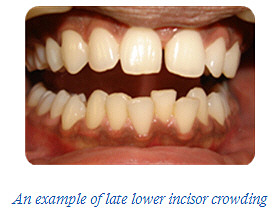online assessment
Find out which treatment is right for you.
fix my smileFor further information about how we use your data, please see our privacy policy
By Daljit Gill BDS, BSc, MSc, FDS RCS, M.Orth, F.Orth RCS (Eng) Consultant Orthodontist, UCLH Eastman Dental Hospital, London UK.
Incisor crowding can have a significant effect on the appearance of the smile and can, in some cases, make it more difficult to keep the teeth clean. It is one of the most common reasons for patients to seek orthodontic treatment. In modern times the problem of incisor crowding may have increased and this has been largely attributed to a number of factors: (1) a gradual reduction in jaw size caused by modern day diets that require less jaw activity to break down food and (2) genetic mixing of populations which has resulted in a mismatch between jaw size and tooth size. In reality the evidence is inconclusive and both factors may play an important role.
The incisors may also become crowded with normal age changes. It is common to see patients who had perfect alignment in young adulthood to become gradually less well aligned with age. This has been termed "late incisor crowding" and its causes are discussed below.
Essentially, crowding is due to a mismatch between jaw size and tooth size. Both upper and lower jaws may be too small to accommodate all the developing teeth. The size of teeth may be increased (macrodontia) or there maybe extra teeth (supernumerary teeth) within the dentition.
Late lower incisor crowding is thought to be due to late lower jaw growth. Evidence would suggest that lower jaw growth occurs well into adulthood. The magnitude of these adults growth changes are small (1-2mm) however they are significant enough to cause movement in the lower incisors that results in crowding.

Originally, it was thought that eruption of wisdom teeth (third molars) may contribute to late lower incisor crowding, however, this is no longer believed to be the case as many people who do not develop wisdom teeth can develop late lower incisor crowding.
Incisor crowding most commonly manifests as tooth displacement from the line of the arch. It is also common to see incisor rotations as rotated incisor teeth take up less space that non-rotated teeth. Very rarely if crowding is severe, a tooth maybe blocked from erupting into the mouth.
It is difficult to prevent incisor crowding if it is noticed in the growing child. Some strategies include extractions or in extremely selected cases arch expansion may be an option. In patients who have received orthodontic treatment, it is essential that retainers are used for as long as well aligned teeth are to be maintained.
There are many different types of orthodontic appliances that can be used to correct incisor crowding. These include fixed appliances or removable appliances such as invisalign. By far the most effective appliance, producing the most predictable results, is the fixed appliance (see article on fixed appliances).
To correct incisor crowding, space must be created to align the teeth. There are several ways of making space:
The exact method chosen depends on a number of factors including the severity of crowding.
Once crowding is corrected it is essential to keep the teeth straight using orthodontic retention (see article on retainers). These should be worn to some degree as long as the teeth are to be kept straight.